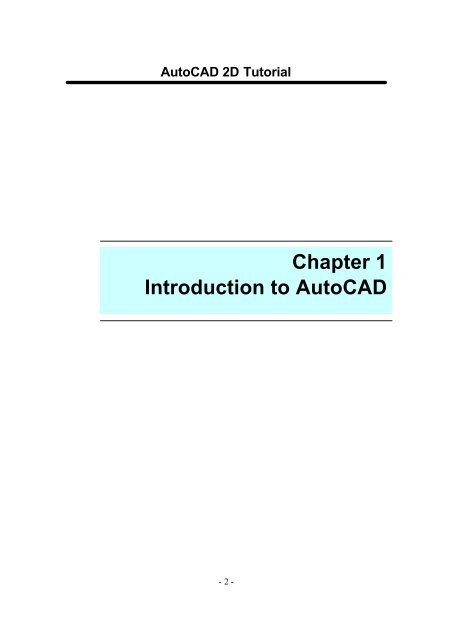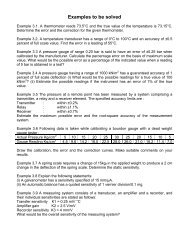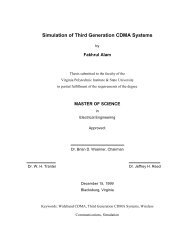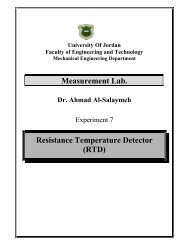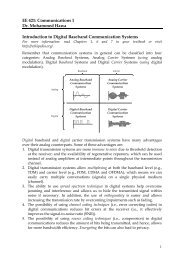Chapter 1 Introduction to AutoCAD - FET
Chapter 1 Introduction to AutoCAD - FET
Chapter 1 Introduction to AutoCAD - FET
You also want an ePaper? Increase the reach of your titles
YUMPU automatically turns print PDFs into web optimized ePapers that Google loves.
Au<strong>to</strong>CAD 2D Tu<strong>to</strong>rial<strong>Chapter</strong> 1<strong>Introduction</strong> <strong>to</strong> Au<strong>to</strong>CAD-2-
Au<strong>to</strong>CAD 2D Tu<strong>to</strong>rialBrowsing the Au<strong>to</strong>CAD InterfaceWhen you first launch Au<strong>to</strong>CAD, you will see the main body of the screen, known as theGraphics Screen. This is where a drawing will be displayed and edited. The rest of theAu<strong>to</strong>CAD interface is how you access and enter Au<strong>to</strong>CAD commands and changesettings in the Au<strong>to</strong>CAD drawing.-3-
Au<strong>to</strong>CAD 2D Tu<strong>to</strong>rial1.1 Launching Au<strong>to</strong>CAD1. Choose Start from the Windows program manager.2. Choose Programs, Au<strong>to</strong>desk ,Au<strong>to</strong>CAD 2004.3. Click the Au<strong>to</strong>CAD 2004 for Windows icon.or4. Choose the Au<strong>to</strong>CAD 2004 icon from the desk<strong>to</strong>p.-4-
Au<strong>to</strong>CAD 2D Tu<strong>to</strong>rial1.2 Text and Graphics ScreensThe graphics screen and the text screen are two different screensavailable in the drawing edi<strong>to</strong>r.1. Press Function key F2 on the keyboard.TIPS:Be sure the Model Tab is highlighted at the bot<strong>to</strong>m of the drawing window.“Layouts” will be covered in a later session.The Cursor must be in the drawing window in order <strong>to</strong> select objects.Maximize the Au<strong>to</strong>CAD windows <strong>to</strong> be full screen. This will make thedrawings bigger and easier <strong>to</strong> read.Use ALT + TAB <strong>to</strong> move between Windows applications.-5-
Au<strong>to</strong>CAD 2D Tu<strong>to</strong>rial1.3 CursorControls the size of the crosshair. The allowable range is from 1 <strong>to</strong> 100percent of the <strong>to</strong>tal screen. At 100% the ends of the crosshair are nevervisible. When the size is decreased <strong>to</strong> 99% or below, the crosshairshave a finite size, and the crosshairs’ ends are visible when moved <strong>to</strong>the edge of the graphics area. The default size is 5%.1. Choose Tools, Options…2. Click the Display TAB.3. Drag the slider bar in the lower left corner of the dialog <strong>to</strong>set the cursor size.1.4 Canceling a Command1. Press the ESCAPE (ESC) key on the keyboard.TIP: Pressing ESC twice clears nested commands.-6-
Au<strong>to</strong>CAD 2D Tu<strong>to</strong>rial1.5 Menus and ColorsPulldown Menus1. Click On the desired Pulldown menu.2. Click On the command <strong>to</strong> be executed from the pulldown.Cascading Pulldown Menus1. Click On a command that has a cascading menu(menus with an arrow <strong>to</strong> the right of the menu)2. Click On the command <strong>to</strong> be executed.CascadingPulldown-7-
Au<strong>to</strong>CAD 2D Tu<strong>to</strong>rial1.6 ToolbarsToolbars can be docked on the screen or they can float about the screen.To Float a Toolbar:1. Choose the gray border surrounding each <strong>to</strong>ol.2. Drag the <strong>to</strong>olbar <strong>to</strong> any area on the screen.To Dock a Toolbar:1. Choose the title or gray border of the <strong>to</strong>olbar.2. Drag the <strong>to</strong>olbar <strong>to</strong> the <strong>to</strong>p, bot<strong>to</strong>m, left, or right area of thegraphics display.DockedToolbarsFloatingToolbarsTIPS:-Holding the CTRL key while dragging will prevent docking.-Toolbars are often a faster way of accessing a command.-Clicking on an icon with the right mouse but<strong>to</strong>n will show a list of allavailable <strong>to</strong>olbars.-8-
Au<strong>to</strong>CAD 2D Tu<strong>to</strong>rialHelp Tooltips1. Move The mouse <strong>to</strong> the <strong>to</strong>olbar but do not pick the but<strong>to</strong>n.Loading Toolbars1. Choose View, Toolbar...or2. Type TOOLBAR at the command promptCommand: TOOLBAR3. Choose the desired <strong>to</strong>olbar <strong>to</strong> load.-9-
Au<strong>to</strong>CAD 2D Tu<strong>to</strong>rial1.7 FilediaSome commands evoke dialog boxes which are typically used <strong>to</strong> enterinformation or change settings. The filedia command suppresses displayof the file dialog boxes.1. Type FILEDIA at the command prompt.Command: filedia2. Enter new value for FILEDIA : 00 Dialog boxes are not displayed. You can still request a file dialog box <strong>to</strong>appear by entering a tilde (~) in response <strong>to</strong> the command's prompt.1 Turns on dialog boxes.0 Turns off dialog boxes.TIPS:-Menu choices that are followed by three dots (...) typically invoke a dialogbox. For example View, Toolbars... calls a dialogue box.-To use the command line version of a dialog box command,enter minus (-) in front of the command.-10-
Au<strong>to</strong>CAD 2D Tu<strong>to</strong>rial1.8 Status BarThe Status Bar is the area below the command line that shows messagesas well as coordinates, modes, and the current time.To activate SNAP, GRID, ORTHO, OSNAP, MSPACE, PSPACE, andTILE, you must double-click on the mode <strong>to</strong> change.Status BarTIP:• Right click on the status bar <strong>to</strong> see the options.-11-
Au<strong>to</strong>CAD 2D Tu<strong>to</strong>rial1.9 Pointing Device (Mouse)Au<strong>to</strong>CAD uses either a mouse or digitizing tablet <strong>to</strong> select objects in adrawing.Left Mouse But<strong>to</strong>nUsed <strong>to</strong> pick or select objects1. Click the left mouse but<strong>to</strong>n <strong>to</strong> select an object area in thedrawing.2. Press ESC twice <strong>to</strong> deselect an object (or <strong>to</strong> cancel acommand).Right Mouse But<strong>to</strong>nUsed <strong>to</strong> enter a command, repeat last command, or access shortcutmenus.1. Click the right mouse but<strong>to</strong>n.LEFTMOUSERIGHTMOUSETIPS:• SHIFT + the right mouse but<strong>to</strong>n brings up the object snap menus.• Various screen locations for the mouse brings up different menus.-12-
1.10 Command PromptTyping a CommandAu<strong>to</strong>CAD 2D Tu<strong>to</strong>rialAll Au<strong>to</strong>CAD commands can be typed in at the command line. Manycommands also have one or two letter aliases that can also be typed asshortcuts <strong>to</strong> the commands.1. Type the desired command at the commandprompt.Command : LINEor2. Type the command’s alias.Command: L3. Press ENTER.4. Type an option at the command prompt.TIP:Many Au<strong>to</strong>CAD commands require you <strong>to</strong> press ENTER <strong>to</strong> complete thecommand. You know you are no longer in an Au<strong>to</strong>CAD command whenyou see a blank command line.CommandPrompt-13-
Reissuing the Last CommandAu<strong>to</strong>CAD 2D Tu<strong>to</strong>rialThe last used Au<strong>to</strong>CAD command can be re-entered by one of thefollowing three methods of ENTER. The ENTER key on the keyboard willalways act as ENTER, the SPACEBAR and RIGHT MOUSE will act asenter most of the time (exceptions include placing TEXT).1. Press the ENTER key on the keyboardor2. Press the Space bar on the keyboard.or3. Click the right mouse but<strong>to</strong>n.-14-
Au<strong>to</strong>CAD 2D Tu<strong>to</strong>rial1.11 UndoReverses the last action.1. Choose Edit, Undo.or2. Click the Undo icon.or3. Press CTRL + Z.4. Type U at the command prompt <strong>to</strong> undo thelast command.Command: URedoReverses the effects of a single UNDO or U command.1. Choose Edit, Redo.or2. Click the Redo icon.or3. Type REDO at the command prompt <strong>to</strong> redo thelast undo command.Command: REDOTIPS:-UNDO has no effect on some commands and system variables, includingthose that open, close, or save a window or a drawing, displayinformation, change the graphics display, regenerate the drawing, orexport the drawing in a different format.-REDO must immediately follow the U or UNDO command.-15-
1.12 Function KeysAu<strong>to</strong>CAD 2D Tu<strong>to</strong>rialKeyboard shortcuts predefined in Au<strong>to</strong>CADF1F2F3F4F5F6F7F8F9F10F11Online HelpFlipscreenOsnap ON/OFFTablet On/OffIsoplane ToggleCoords On/OffGrid On/OffOrtho On/OffSnap On/OffPolar On/OffObject Snap Tracking ON/OFF-16-
1.13 Accelera<strong>to</strong>r KeysAu<strong>to</strong>CAD 2D Tu<strong>to</strong>rialPressPressPressPressPressPressPressPressPressPressPressPressPressPressPressPressCTRL + A <strong>to</strong> turn GROUPS on/off.CTRL + B <strong>to</strong> turn SNAP on/off.CTRL + C <strong>to</strong> COPYCLIPCTRL + D <strong>to</strong> turn COORDS on/off.CTRL +E <strong>to</strong> Toggle Isoplane settings.CTRL +F <strong>to</strong> turn Osnaps ON/OFFCTRL + G <strong>to</strong> turn GRID on/off.CRTL + K for HyperlinksCTRL + L <strong>to</strong> turn ORTHO ON/OFFCTRL + N <strong>to</strong> create a NEW drawing.*CTRL + O <strong>to</strong> OPEN an existing drawing.*CTRL + P <strong>to</strong> PLOT a drawing.*CTRL + S <strong>to</strong> qsave a drawing.*CTRL + T <strong>to</strong> turn the digitizing table<strong>to</strong>n/off.CTRL + X <strong>to</strong> cut <strong>to</strong> Clipboard.*CTRL + Z <strong>to</strong> UNDOTypical in any Microsoft Windows application.TIPS:You can define your own shortcut keys (or accelera<strong>to</strong>r keys). Thefollowing is a short example of an Accelera<strong>to</strong>rs section in an MNU file.***ACCELERATORSID_Line [SHIFT+CONTROL+"L"][CONTROL+"Q"]^C^C_quit[CONTROL+SHIFT+"Z"]^C^Czoom extents-17-
1.14 On-Line HelpAu<strong>to</strong>CAD 2D Tu<strong>to</strong>rial1. Choose Help, Au<strong>to</strong>CAD Help.or2. Click the Help icon.or3. Type HELP at the command promptCommand: HELPor4. Press Function Key F1-18-


